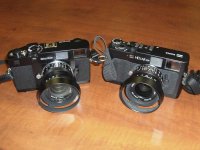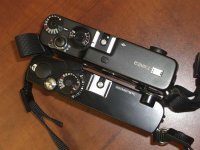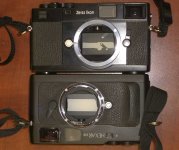amateriat
We're all light!
Well, once again, I was off across the river to assist someone on a tech job. And, once again, he brought his newly-acquired Zeiss Ikon with him. This time, though, I brought my Hexars as well, in the name of setting up an after-work comparison for everyone out here who might be curious about the cameras' similarities and differences. Last time out, I declared that the ZI is the near-perfect non-motorized body to use alongside a Hexar, or the camera to grab when you know anything with a motor (except perhaps a Hexar AF) isn't going to work at all. Now I have a bit of photographic evidence to this end.

I like the finish of the ZI: neat, straightforward and businesslike. Nothing distracting. Funny how that's becaome rather novel in a new camera these days...

Controls: yes, there's a bit of a difference here; the Hexar's shutter-speed/exposure-mode dial is out at the edge of the body, while the ZI's is well-inboard. Ah, but, in my case anyway, I'd likely be using both cameras in AE mode roughly 75% of the time. The exposure control counts a bit more often, besides exposure-lock, is the exposure-compensation dial. Look at the similarity in location in this case. (Though, yes, I see that the dials are biased in opposite directions. This would not keep me up nights.) (Edit: In fact, the direction of operation is identical, although just glancing at the dials would have you think otherwise.)
Both cameras are near-identical in height, width and depth, and have rather similar handling characteristics, in spite of the fact that, as Konica chose to square-off the camer at all corners, while Leicas are fully-rounded, Zeiss splits the difference with squared contours at the front of the body, and softly-rounded corners at the back.
(Edit 2: You might have noticed the film-plane indicator on the Hexar's top plate. The ZI has one as well, hidden under the film-advance lever. Why there? You tell me.)

As much as I like CVs, one deal-breaker has been the manual frameline-setting arrangement. A lot of people can live with it, and that's fine. I can't. The ZI, of course, aces this one. I also love the VF overall. Both cameras' shutters betray their OTF metering arrangement in this photo. (Note: yes, this Hexar's lens mount is a tad scratched up. I'm not kidding when I say I put a lot of mileage on the things.)
On to Part Two.
- Barrett
I like the finish of the ZI: neat, straightforward and businesslike. Nothing distracting. Funny how that's becaome rather novel in a new camera these days...
Controls: yes, there's a bit of a difference here; the Hexar's shutter-speed/exposure-mode dial is out at the edge of the body, while the ZI's is well-inboard. Ah, but, in my case anyway, I'd likely be using both cameras in AE mode roughly 75% of the time. The exposure control counts a bit more often, besides exposure-lock, is the exposure-compensation dial. Look at the similarity in location in this case. (Though, yes, I see that the dials are biased in opposite directions. This would not keep me up nights.) (Edit: In fact, the direction of operation is identical, although just glancing at the dials would have you think otherwise.)
Both cameras are near-identical in height, width and depth, and have rather similar handling characteristics, in spite of the fact that, as Konica chose to square-off the camer at all corners, while Leicas are fully-rounded, Zeiss splits the difference with squared contours at the front of the body, and softly-rounded corners at the back.
(Edit 2: You might have noticed the film-plane indicator on the Hexar's top plate. The ZI has one as well, hidden under the film-advance lever. Why there? You tell me.)
As much as I like CVs, one deal-breaker has been the manual frameline-setting arrangement. A lot of people can live with it, and that's fine. I can't. The ZI, of course, aces this one. I also love the VF overall. Both cameras' shutters betray their OTF metering arrangement in this photo. (Note: yes, this Hexar's lens mount is a tad scratched up. I'm not kidding when I say I put a lot of mileage on the things.)
On to Part Two.
- Barrett
Attachments
Last edited:




